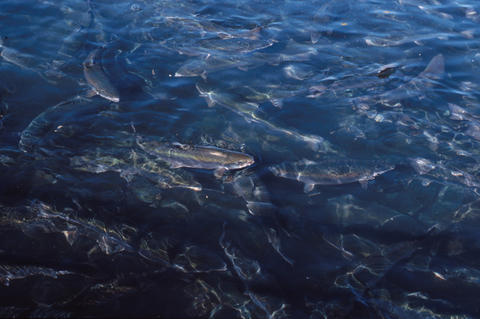
Salmon swimming within a netted pen at a fish farm in Maine.
A research team at the National Institute of Standards and Technology (NIST) has provided the first look at a genetic structure that may play a critical role in the reproduction of the infectious salmon anemia virus (ISAV), more commonly known as the "fish flu." A scourge in fish farms with a mortality rate as high as 90 percent, ISAV was recently found in wild salmon in the Pacific Northwest for the first time, threatening an already dwindling population and the vast food web it supports.
While there is a vaccine for the virus, it must be administered by injection—a task that is both cumbersome and economically impractical for the aquaculture industry. A drug or vaccine that prevents the spread of the disease by interfering with the virus' ability to replicate its genetic code (contained in eight segments of ribonucleic acid or RNA) would be far more practical for fish farmers and marine biologists to deliver.
Robert Brinson, a NIST scientist working at the Hollings Marine Laboratory (HML) in Charleston, S.C., and NIST colleagues Andrea Szakal and John Marino working at the Institute for Bioscience and Biotechnology Research (IBBR) in Rockville, Md., knew from the scientific literature that the family of viruses that includes both the many types of influenza—the causes of yearly human flu outbreaks—and infectious salmon anemia, form "panhandle" structures in their genomic RNA. In human influenza, these panhandles are known to interact with proteins that begin the process of copying and replicating the virus.
Hypothesizing that the fish flu virus might function the same way, Brinson and his colleagues used high-resolution nuclear magnetic resonance (NMR) spectroscopy and thermal melting methods to look at the genetic structure in the same region of the ISAV RNA. They found that the ISAV genome does appear to have a panhandle "motif" (the poetic term used by geneticists to define a discrete nucleotide sequence that functions independently of the rest of the genome and directs a specific biological function). The NIST work provides the first experimental evidence and characterization of this panhandle motif that may function similarly in the fish virus as the "green light" for viral RNA replication processes.
"The next step," Brinson says, "is to investigate the relevant proteins and how they interface with the RNA. What molecular features drive the protein to recognize the RNA? How is it binding, and how is it interacting with the RNA?" Brinson says that this work may facilitate the development of new approaches for interfering with the replication of these viruses to mitigate the effects of ISAV on the aquaculture of salmon. It also demonstrates that the salmon virus can be used as an experimental model for understanding the replication machinery of human and other related influenza viruses.
The HML is a unique partnership of governmental and academic agencies including NIST, NOAA's National Ocean Service, the South Carolina Department of Natural Resources, the College of Charleston and the Medical University of South Carolina. The HML NMR facility focuses on the multi-institutional mission of metabolomics, natural products and structural biology. The IBBR is a University System of Maryland joint research enterprise created to enhance collaboration among the University of Maryland College Park, The University of Maryland Baltimore and NIST.
R.G. Brinson, A.L. Szakal and J.P. Marino. Structural characterization of the viral and complementary RNA panhandle motifs from the Infectious Salmon Anemia Virus. Journal of Virology. Published online Oct. 12, 2011.

